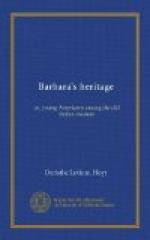Margery began, and told how he used always to wear a sketch-book attached to his girdle as he walked through the streets of Florence, so that he might make a sketch of any face whose expression especially attracted him; how he would invite peasants to his studio and talk with them and tell laughable stories, that he might study the changes of emotion in their faces; and how he would even follow to their death criminals doomed to execution, in order to watch their suffering and horror.
“He did not care much for the form or coloring or beauty of faces;—only for the expression of feeling,” she added.
“But,” said Malcom, after waiting a moment for the others to speak if they chose, “he studied a host of other things, also. For in the letter he sent to Duke Ludovico of Milan asking that he might be taken into his service, he wrote that he could make portable bridges wonderfully adapted for use in warfare, also bombshells, cannon, and many other engines of war; that he could engineer underground ways, aqueducts, etc.; that he could build great houses, besides carrying on works of sculpture and painting. And there were many other things that I do not now remember. It seems as if he felt himself able to do all things. I believe he did make a magnificent equestrian statue of the duke’s father. And he studied botany and astronomy, anatomy and mathematics, and all sorts of things besides. I really do not see how he could have got much painting in.”
“He has left only a very few pictures to the world,” said Barbara. “We saw two or three at Florence, but I think only one—that unfinished Adoration of the Magi—is surely his. We shall see the Last Supper and Head of Christ at Milan. Then there are two or three in Paris and one in London I think these are all,” and she looked inquiringly at Mr. Sumner, who smilingly nodded confirmation of her words.
“But,” she went on, with an answering smile, “I do not think this was due to lack of time, for on these few pictures he probably spent as much time as ordinary artists do in painting a great many. He was never satisfied with the result of his work. His aims were so high and he saw and felt so much in his subjects that he would paint his pictures over and over again, and then often destroy them because he could not produce what he wished. I think he was one of the most untiring of artists.”
“I have been especially interested,” said Bettina, after a minute or two, “in the story of the Last Supper which we shall soon see.”
She then went on to tell the sad tale of Beatrice d’Este,—the good and beautiful wife of harsh, wicked Duke Ludovico. How she used to go daily to the church Santa Maria delle Grazie to be alone,—to think and to pray; and how, after her early death, the duke, probably influenced by remorse because of his cruelty to her, desired Leonardo to decorate this church and its adjoining




